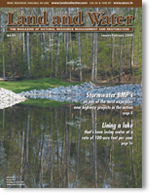Features Available Online
Fighting for Caddo Lake
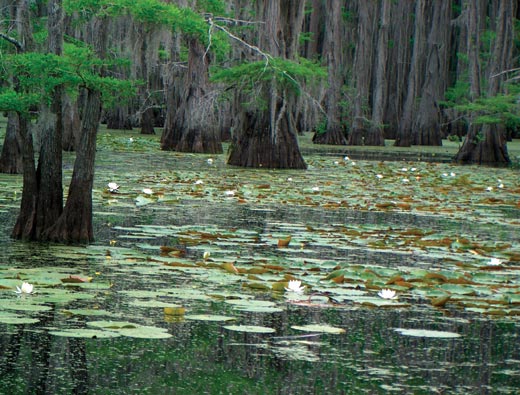
Caddo Lake native plant species in early May: fragrant water lily, floating bladderwort, and bald cypress.
A Lake With Many Faces
Caddo Lake is the largest naturally formed lake in Texas. It straddles the Texas-Louisiana border and is just a short drive west of Shreveport, Louisiana. Caddo Indian legend attributes the formation of the lake to a giant flood. Scientists believe floodwaters, blocked by massive log jams on the Red River, backed up into the Cypress Bayou watershed, forming the lake. The discovery of oil in the 1900’s led to the construction of a man-made weir that raised the water level on Caddo Lake and allowed for over-the-water drilling. A new dam replaced the old one in 1971. Caddo Lake has seen a lot of history and has provided a wide variety of benefits for many people.
But history aside, Caddo Lake is much more than just a lake. Presently, Caddo Lake is held in place by a simple earthen weir constructed at Mooringsport, Louisiana. There are no water control structures on the weir and excess water simply rolls over the top and empties into Twelve Mile Bayou. Caddo Lake covers about 33,000 acres and the average depth is around 8-10 feet. The eastern portion of Caddo Lake is predominantly open water that falls inside the Louisiana state line. However, looking back to the west and into Texas, the landscape changes. Traditionally, the far western border of the lake is the Texas State Hwy 43 Bridge that crosses Big Cypress Bayou. Generally one pictures a lake as having an obvious shoreline and it is clear where the water stops and the land begins. At the Texas end of Caddo Lake, that line is blurred by many of acres of forested wetlands composed primarily of baldcypress swamps and hardwood bottomlands. These flora- and fauna-rich habitats are listed as rapidly declining in the state of Texas.
Caddo Lake is not simply an open, all-you-see-is-water lake. It includes a maze of backwater sloughs, seasonally flooded bottomland forest, and shallow water areas thick with bald cypress trees draped in Spanish moss as well as other aquatic plant species. It is this area of Caddo Lake that brings people from all over the world and is often described as mysterious, primitive, and exotic. Some have even called it loud; loud with the sounds of nature. Caddo Lake provides habitat for a tremendous number of wildlife species, including more than 200 birds, close to 30 amphibians, 60 reptiles, 55 mammals, and more than 90 species of fish. Most importantly, all of these animal species would not find Caddo Lake so appealing if it were not for the diverse plant species present. Caddo Lake has it all; well drained upland areas, rich mesic slope forests, seasonally flooded bottomland floodplain forests, permanently flooded bald cypress forests, dark murky sloughs, soft shallow shorelines, rich fluctuating shoreline zones, and deeper open water with abundant underwater debris providing ideal fish habitats.
In March of 1992, Texas Parks and Wildlife Department (TPWD) realized the need to protect Caddo Lake and began the process of purchasing roughly 8,000 acres of primarily bald cypress swamp and flooded hardwood bottomland located on the shores of Big Cypress Bayou and Caddo Lake near Karnack, Texas establishing the Caddo Lake Wildlife Management Area (CLWMA). This purchase was made through the Texas Nature Conservancy using funds from TPWD, The Nature Conservancy, United States Fish and Wildlife Service (USFWS), General Land Office (GLO) and funds granted by the North American Wetlands Conservation Council as a Federal Challenge Grant. Approximately 6,500 acres can be described as bald cypress swamp, bottomland hardwood floodplains, and open water. About 1,500 acres can be described as well drained rich uplands. CLWMA encompasses the far western areas of Caddo Lake.
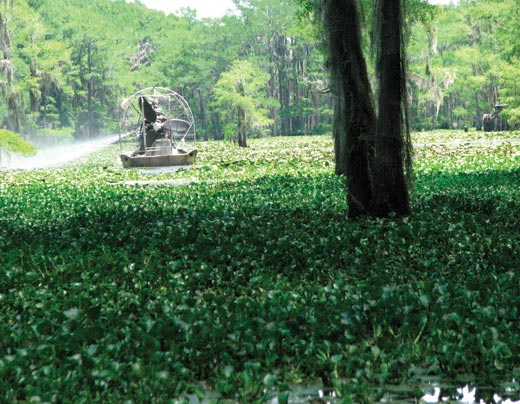
Spraying waterhyacinth on Caddo Lake.
On October 23, 1993, 20,000 acres that included CLWMA, the Caddo Lake National Wildlife Refuge (CLNWR), and privately owned lands were designated as “A Wetland of International importance, Especially as Waterfowl Habitat” by the Ramsar Convention. The Ramsar Convention is an intergovernmental treaty with over 150 participating nations and five international organizational partners including Bird Life International, World Wildlife Fund, the International Water Management Institute, Wetlands International and the World Conservation Union that provides a framework for international cooperation in conservation of wetland habitats. There are twenty-four other such sites in the United States with Caddo Lake being the first and only one in Texas. This designation places Caddo Lake into an international spotlight.
Giant salvinia, an aquatic fern, is not believed to produce a viable spore but instead spreads by vegetation growth and fragmentation. It can survive from small fragments and has the ability to double its numbers in 2 to 10 days; producing mats up to 2 feet thick. Giant salvinia can completely cover waterways preventing the passage of sunlight and oxygen that native plants, fish, insects and other species require -- essentially killing a body of water. It can make water surfaces look like a putting green, eliminating recreational opportunities including boating, fishing, and hunting. It can also result in shutting down water intakes and power generation stations.
The Invasion Begins
In late May 2006, giant salvinia (Salvinia molesta), was discovered on Caddo Lake in Louisiana and soon after was spotted in Texas near the state line. Only a few months later, it was found on the far southeastern section of the CLWMA in an area known as Turtle Shell. By the fall of 2007, it was discovered in the far western areas of CLWMA in Carter’s Lake, Lone Pine Stretch, Bird Roost and Back Lake. Earlier that summer, TPWD fisheries biologists estimated that over 3,600 acres of Caddo Lake, TX were covered by waterhyacinth, making it difficult to accurately estimate the size of the giant salvinia infestation. Estimates at that time were that giant salvinia infested 100-500 acres in Texas alone. It is difficult to ascertain exactly how many acres of Caddo Lake are infested with giant salvinia because of the plant’s tendency to hide in other vegetation and because of the fact that many areas surrounding the lake are inaccessible.
| It can survive from small fragments and has the ability to double its numbers in 2 to 10 days; producing mats up to 2 feet thick. |
The uniqueness of Caddo Lake not only provides a rich diversity of plants and animals, it also provides obstacles that make treating and managing threats such as giant salvinia, waterhyacinth, and hydrilla very difficult. The shallow, still, fertile and warm waters of the swamp provide ideal growing conditions for non-native invasive aquatic plants like giant salvinia and waterhyacinth both native to South America. State agencies and private land owners have been fighting waterhyacinth on Caddo Lake for several decades, but the discovery of giant salvinia on Caddo Lake was an event that wildlife and fisheries biologists have been dreading since it was first discovered in Texas in 1998
| ..the discovery of giant salvinia on Caddo Lake was an event that wildlife and fisheries biologists have been dreading since it was first discovered in Texas in 1998. |
Giant salvinia is easily spread by boaters, hunters, and water recreation enthusiasts when it attaches to boats and boat trailers, duck decoys and dogs, live wells and bilge pumps, waders and mud boots. Anything that comes in contact with the plant has the potential to infest different lake areas and other water bodies. It is also believed that birds and other wildlife species that come in contact with the fern can potentially spread it. Caddo Lake WMA is especially vulnerable to infestation for several reasons: the still waters of the swamps are conducive to the invasive fern’s growth; high nutrient loads feed it; other dense vegetation easily hides and shelters the fern; and timely discovery is often difficult due to the inaccessibility of the bald cypress breaks, not to mention the diverse array of wildlife that may come in contact with the fern and spread it.
Controlling giant salvinia in Caddo Lake is exacerbated by the heavy infestation of waterhyacinth. As it hides very well in other vegetation (especially true with waterhyacinth). As a result waterhyacinth also must be treated to effectively combat giant salvinia.
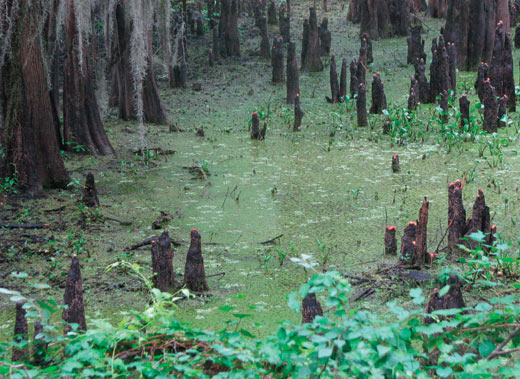
Giant salvinia will grow in areas that are inaccessible preventing herbicide application or removal.
Caddo Lake is unique as a naturally formed lake because it does not have a single governing agency. Man-made reservoirs are generally owned by entities such as river authorities, cities, counties, or the US Army Corp of Engineers. Other than the 8,000 acres owned by TPWD, and though all the waters of Caddo Lake are public, the shores of Caddo Lake are privately owned. The boat channels of Caddo Lake are maintained by the Cypress Valley Navigation District (CVND), but they have been under-funded and poorly equipped to take on the monumental task of combating giant salvinia. TPWD Inland Fisheries Division is tasked with the job of aquatic vegetation control for the public waters in the state of Texas and are not adequately equipped or funded to fight invasive vegetation in all the public waters of Caddo Lake in addition to all the other public waters in the state.
TPWD along with the USFWS, Greater Caddo Lake Association (GCLA), Cypress Valley Navigation District (CVND), Caddo Lake Institute (CLI), Ducks Unlimited (DU), the newly formed Neighborhood Shoreline Watch Organization, Harrison County, City of Marshall, Texas Commission on Environmental Quality (TCEQ), and individuals recognize the urgency of controlling giant salvinia on Caddo Lake, and are cooperating to combat this invasion. All have contributed emergency funds and many volunteer hours to prevent the loss of Caddo Lake to giant salvinia. State Senator Kevin Eltife and State Representative Bryan Hughes successfully lobbied for emergency funds for CVND especially for the treatment and management of giant salvinia and waterhyacinth on Caddo Lake. CVND went straight to work. They purchased herbicides, acquired herbicide applicators licenses and began making applications using small johnboats and 25 gallon spray tanks. With all this positive effort, it soon became clear that they needed a bigger boat.
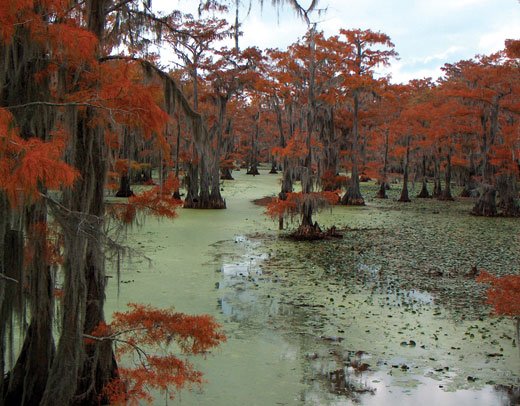
Caddo Lake Wildlife Management Area in the fall.
So, in early summer 2008, TPWD donated a used airboat to CVND. Using funds the senators had secured, CVND replaced the motor and plumbed the airboat to function as the dedicated spray boat to treat and manage giant salvinia and waterhyacinth on Caddo Lake. The airboat and its crew made its first productive voyage on Memorial Day 2008; spraying nearly 30 acres of waterhyacinth. Since then they have sprayed more than 1,100 acres of giant salvinia and waterhyacinth.
The following have contributed emergency funds and many volunteer hours to prevent the loss of Caddo Lake to giant salvinia.
State Senator Kevin Eltife and State Representative Bryan Hughes successfully lobbied for emergency funds for CVND especially for the treatment and management of giant salvinia and waterhyacinth on Caddo Lake. |
Waterhyacinth is treated with relatively inexpensive 2-4-D herbicides. Fighting the invasive fern effectively, however, requires the combination of two different herbicides; diquat and glyphosate. Diquat herbicides are systemic herbicides and once absorbed will attack the plant’s systems. Results are generally noticed in 7 to 14 days. Glyphosate herbicides are foliar herbicides that will “burn” or wilt the target plants almost overnight, a necessary step when fighting giant salvinia on a limited budget. Knowing where you have already sprayed is very important to prevent over spraying and wasting herbicides. This formula has proven a very effective first response after the discovery of giant salvinia. Generally, giant salvinia requires more than one application of herbicide because of the plant’s tendency to grow in mats with top layers protecting the lower layers from herbicides.
Providing Caddo Lake with a dedicated spray team was an important step in controlling non-native invasive plant species on Caddo Lake. As one can imagine, the treatment of giant salvinia and waterhyacinth are time consuming. Daily herbicide applications are required to get ahead of the fast growing plants. Giant salvinia and waterhyacinth are found on several water bodies in Texas, and TPWD’s Aquatic Vegetation Biologist and his small team are unable to dedicate that kind of time to just one lake. With all involved recognizing this, the creation of the dedicated spray team was a logical solution. The spray team is proving to be a monumental asset to Caddo Lake, and now, providing the dedicated spray team with herbicides needed for the fight to save Caddo Lake is of the utmost importance. To this end, DU recently donated $20,000 of diquat and glyphosate herbicides for the treatment and management of giant salvinia on CLWMA through a gift from Syngenta. Clearly defending the rich cypress sloughs and flooded bottomlands from giant salvinia is a priority for those who value Caddo Lake’s waterfowl and other wetland species.
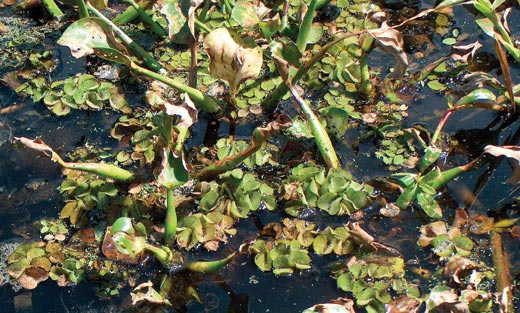
Giant salvinia commonly grows with waterhyacinth and other vegetation.
Caddo Lake has faced many challenges in its history. The discovery of giant salvinia on Caddo Lake was a blow to conservation agencies, city officials, area businesses and many local residents. The area provides many recreational and educational opportunities and many local residents make their living and raise their families on and around Caddo Lake. Realizing that Caddo Lake could be drastically altered by this unwanted invader is devastating. Many liken the infestation to having a cancer and the thought of losing this valuable wetland was just not an option.
The silver lining in this current cloud of conflict with giant salvinia is the rich partnership that has developed. Early in the process, everyone sprang into action and sought assistance every way they knew how. They called the media and invited local elected officials so that they could understand what was at stake. They wrote letters to public servants explaining Caddo Lake’s plight and the need to be proactive in the fight against non-native invasive species. Local residents made every effort to educate themselves about giant salvinia and took every opportunity to educate others about it. Many local residents volunteered for a short class of how to remove and properly dispose of giant salvinia in order to be legally permitted to transport it for proper disposal. And they volunteered their time to remove and dispose of giant salvinia. Caddo Lake is too unique a natural treasure to allow it to be marred by an invasive plant. In the end we are confident that the partners’ united front will prevail, and Caddo Lake’s, primitive, exotic character will be preserved for the generations to follow.![]()
For more information, contact Vanessa Adams, Area Biologist, Texas Parks and Wildlife Department, Caddo Lake Wildlife Management Area, P.O. Box 226, Karnack, TX 75661, phone (903)679-9817, fax (903)679-9823, e-mail: Vanessa.adams@tpwd.state.tx.us, www.tpwd.state.tx.us or Keith McKnight, Ph.D., Regional Biologist, Ducks Unlimited, Inc., 3334 SSW Loop 323, Ste. 110, Tyler, TX 75701, phone (903)581-9570, fax (903)581-2231, e-mail: kmcknight@ducks.org, www.ducks.org.

